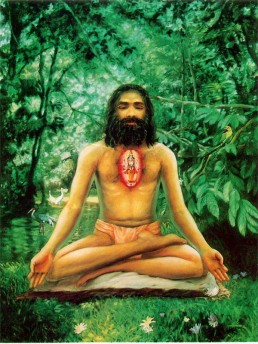Swami Chinmayananda
Swami Chinmayananda Commentary
If meditation is the path by which one can gain tranquillity and equal-vision within oneself, it is necessary that, in this text-book on self-perfection, Lord Krishna should give a complete and exhaustive explanation of the technique of meditation. In order to fulfil this demand, hereunder we get a few verses explaining the position, the means and the ends of a meditator at his work.
In these words is a description of the seat and the place for perfect meditation.
“IN A CLEAN PLACE” — This is important inasmuch as the external conditions have a direct bearing upon the human mind. In a clean place there is more chance for the seeker to maintain a cleaner mental condition. Apart from this, commentators explain that the place should be rid of mosquitoes, house-flies, bugs, ants and such other creatures that may disturb the beginner’s mental concentration which he is trying to turn inward.
In his seat, the meditator is asked to sit steady (Sthiram). Without moving the physical body at short intervals and without swinging the body either forward and backward or sideways, the seeker is asked to get firmly established on his seat, because physical movement immensely contributes to the shattering of mental concentration and inner equipoise. This is very well realised by all of us, if we only remember our attitude when we are sincerely and seriously thinking over something. In order to get established in a firm posture it would be advisable to sit in any “comfortable seat” (Asana), with the vertebral column erect, fingers interlocked and hands thrown in front.
Adding more details, Krishna says that the seat of meditation “should not be too high or too low.” If it is too high there will be a sense of insecurity in the meditator, created as a result of instinct of self-preservation, and he will find it difficult to extricate himself from his outer-world-consciousness and plunge himself into the inner. Again, we are told that the seat should not be too low; this is to avoid the mistake of meditating in any damp under-ground cellar, where perchance, the seeker may develop rheumatic pains in his body. During meditation the heart-action becomes slightly low, and, to the extent we are withdrawn into ourselves, even the blood pressure falls. At such a time of low resistance, if the place be damp, there is a great chance of a seeker developing pains in his joints. To avoid such troubles, the warning is given here.
When the Geeta is out to give details, she leaves nothing to the imagination of the student. The exhaustive details regarding the ideal seat for meditation is an example. It is said here that a mattress of Kusha-grass on the ground, with a deer-skin covered with a piece of cloth on top of it, is the perfect seat for long meditations. Dampness is avoided by the Kusha-grass which keeps the seat warm during winter. In summer the skin becomes too hot and some seekers are allergic to the animal skin, especially when their skin has become slightly moist with perspiration. This contingency is being avoided by spreading over the skin a piece of clean cloth. Having thus established himself firmly on the meditation seat, prepared as above, what exactly he is to do mentally and intellectually, is now explained.
WHAT SHOULD BE DONE AFTER ESTABLISHING ONESELF UPON THE PREPARED SEAT?
Adi Sankara Commentary
Pratisthapya, having established; sthiram, firmly; sucau, in a clean; dese, place, which is solitary, either naturally or through improvement; atmanah, his own; asanam, seat; na ati ucchritam, neither too high; na ati nicam, nor even too low; and that made of caila-ajina-kusa-uttram, cloth, skin, and kusa-grass, placed successively one below the other-the successive arrangement of cloth etc. here is in a reverse order to that of the textual reading-. What follows after thus establishing the seat? Upavisya, sitting; tatra, on that; asane, seat; yogam yunjyat, he should concentrate his mind. To what purpose should he concentrate his mind? In answer the Lord says: atma-visuddhaye, for the purification of the internal organ. How? Krtva, making; manah, the mind; ekagram, one-pointed,by withdrawing it from all objects; and yata-citta-indriya-kriyah, keeping the actions (kriyah) of the mind (citta) and senses (indriya) under control (yata). The external seat has been spoken of. Now is being stated how the posture of the body should be:
The Bhagavad Gita with the commentary of Sri Sankaracharya – Translated by Alladi Mahadeva Sastry
Holy Geeta – Commentary by Swami Chinmayananda
The Bhagavad Gita by Eknath Easwaran – Best selling translation of the Bhagavad Gita
The Bhagavad Gita – Translation and Commentary by Swami Sivananda
Bhagavad Gita – Translation and Commentary by Bhaktivedanta Swami Prabupadha
Srimad Bhagavad Gita Chapter 6 – Verse 11 – 6.11 sucau dese – All Bhagavad Gita (Geeta) Verses in Sanskrit, English, Transliteration, Word Meaning, Translation, Audio, Shankara Bhashya, Adi Sankaracharya Commentary and Links to Videos by Swami Chinmayananda and others – 6-11

